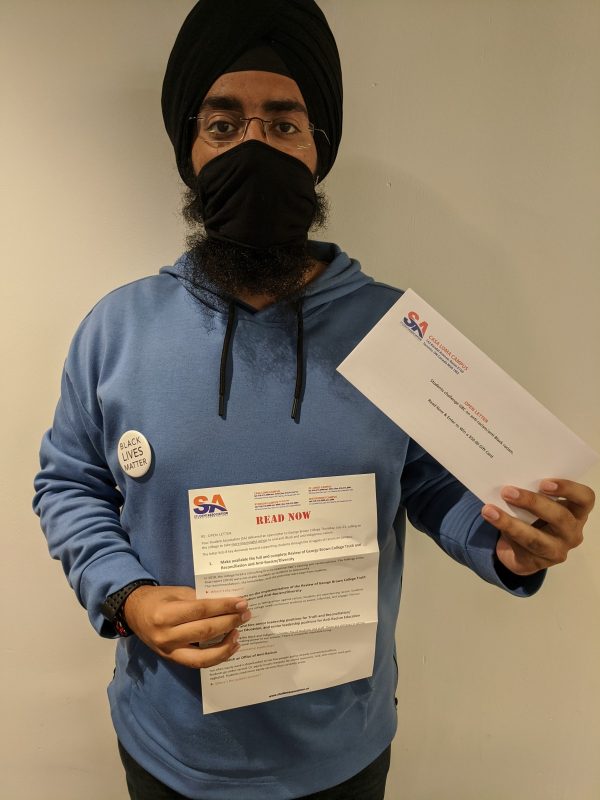By Maud Weaver
On July 23, 2020 the Student Association of George Brown College (SAGBC) released an open letter addressed to President Anne Sado and several other members of the college’s senior leadership which outlined eight demands for eliminating racism at George Brown College (GBC). Over a month later, the SAGBC is still wondering what action has been taken and where the college stands.
This summer popularized conversations on anti-Black and anti-Indigenous racism, policing, and white supremacy in the wake of police killings. These conversations have included calls to action on restructuring leadership, defunding and dismantling the police, and holding institutions accountable.
These conversations helped inspire SAGBC’s director of education and equity, Taranjeet Singh Manchanda and community care coordinator, Michelle Pettis, to write the open letter. Among their demands are calls for more transparency, the implementation of more Black and Indigenous people in leadership roles and the establishment of a GBC-wide Anti-Racism Council.
The Dialog is funded by the SAGBC.
Today SAGBC delivered a letter to @GBCollege demanding more action be taken to address racism. The letter included eight demands for action #GBC should take to support anti-racism advocates. Visit our webpage to learn more and read the full letter. https://t.co/Az78BN95dt
— SA of GBC (@sagbc) July 23, 2020
Though the college acknowledged the receipt of this letter privately on August 27, there has yet to be a public response from the college. But Leslie Quinlan, VP of human resources and public safety and security at the college, who was copied on the open letter, says they “had nothing to hide and are not against releasing one,” and that the college is “looking forward to working in partnership with the SA.”
George Brown released their own Anti-Racism Strategy on July 7, which outlines 3 objectives to build structures and competency around challenging racism, increase Black and Indigenous representation, and increase awareness of anti-racism. But the SAGBC does not feel like these three strategies are enough and says they will continue to push for all eight of their demands.
The Anti-Racism and Equity Advisory Committee has now also been created to “establish a GBC-wide anti-racism council with involvement of faculty, students, and staff” according to an email sent out by Sado to students and faculty. Their first meeting will occur on September 30, 2020.
Manchanda believes this is a good start, but Pettis, who runs the Community Care Centre, a SAGBC program which is aimed at supporting traditionally underrepresented groups, says there are concerns around the committee’s formal structure which may lead to the dismissal of certain voices, lack of transparency, and having decisions be made behind closed doors.
“People retreat to solve deeply, but they are not communicating, so students on the other side can only come to one conclusion: that they’re not being communicated to or nothing’s happening, or that they don’t matter,” said Pettis.

Taranjeet Singh Manchanda poses with the open letter he signed and delivered to GBC leadership.
Quinlan says that while the college is unsure of what the process will currently look like, the committee will be committed to releasing regular reports on its actions and initiatives. She says there will also be subcommittees built for specific initiatives to engage students further in the process.
Earlier this week, the college hired a director of Indigenous initiatives, former Saskatchewan MLA Jennifer Campeau, and Quinlan says they are in the process of hiring a director of anti-racism, equity, and human rights which relates to the college’s own three objective strategy as well as one of the SAGBC’s eight demands.
Pettis and Manchanda feel these are partial wins that should be noted, but that further advocacy is necessary.
“How are students going to come together to make those meaningful wins?” said Pettis. “So less of the performative allyship and more around the talks of accountability.”
The SAGBC has felt the most resistance to their demand to “reopen the First Aid Offices with a commitment to culturally competent care” which addresses the presence and toll of security on campus after a summer of increased conversations about defunding the police.
“When racialized students see campus security, it is tied to the feelings of not belonging,” said Pettis. “Real or perceived, it’s tied to hyper surveillance.”
But Pettis said that the college firmly dismissed this demand.
“I think that if the college isn’t building the trust relationships to tap into that Black brilliance and the Black peer wisdom then none of their policies, none of their change-making is going to be complete,” said Pettis.


